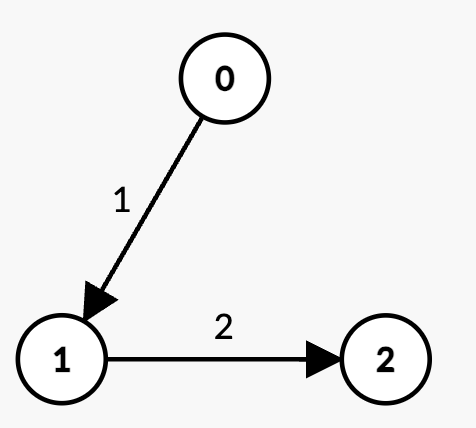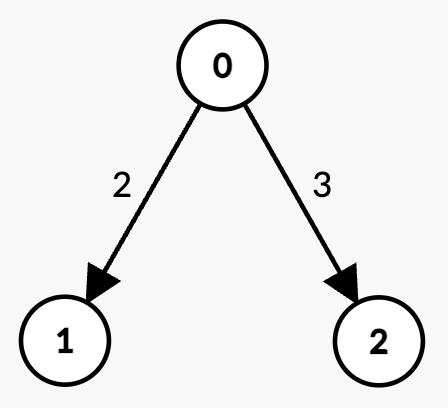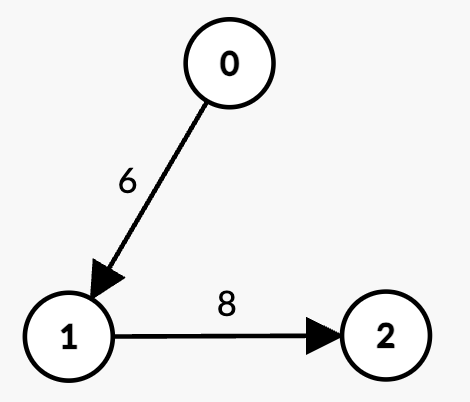Description
You are given an integer n and a Directed Acyclic Graph (DAG) with n nodes labeled from 0 to n - 1. This is represented by a 2D array edges, where edges[i] = [ui, vi, wi] indicates a directed edge from node ui to vi with weight wi.
You are also given two integers, k and t.
Your task is to determine the maximum possible sum of edge weights for any path in the graph such that:
- The path contains exactly
kedges. - The total sum of edge weights in the path is strictly less than
t.
Return the maximum possible sum of weights for such a path. If no such path exists, return -1.
Example 1:
Input: n = 3, edges = [[0,1,1],[1,2,2]], k = 2, t = 4
Output: 3
Explanation:

- The only path with
k = 2edges is0 -> 1 -> 2with weight1 + 2 = 3 < t. - Thus, the maximum possible sum of weights less than
tis 3.
Example 2:
Input: n = 3, edges = [[0,1,2],[0,2,3]], k = 1, t = 3
Output: 2
Explanation:

- There are two paths with
k = 1edge:<ul> <li><code>0 -> 1</code> with weight <code>2 < t</code>.</li> <li><code>0 -> 2</code> with weight <code>3 = t</code>, which is not strictly less than <code>t</code>.</li> </ul> </li> <li>Thus, the maximum possible sum of weights less than <code>t</code> is 2.</li>
Example 3:
Input: n = 3, edges = [[0,1,6],[1,2,8]], k = 1, t = 6
Output: -1
Explanation:

- There are two paths with k = 1 edge:
0 -> 1with weight6 = t, which is not strictly less thant.1 -> 2with weight8 > t, which is not strictly less thant.
- Since there is no path with sum of weights strictly less than
t, the answer is -1.
Constraints:
1 <= n <= 3000 <= edges.length <= 300edges[i] = [ui, vi, wi]0 <= ui, vi < nui != vi1 <= wi <= 100 <= k <= 3001 <= t <= 600- The input graph is guaranteed to be a DAG.
- There are no duplicate edges.
Solution
Python3
class Solution:
def maxWeight(self, n: int, edges: List[List[int]], K: int, T: int) -> int:
graph = defaultdict(list)
topo = []
for u, v, w in edges:
graph[u].append((v, w))
@cache
def dp(node, k, t):
if k == K: return t
res = -inf
for adj, w in graph[node]:
if t + w < T:
res = max(res, dp(adj, k + 1, t + w))
return res
ans = -inf
for node in range(n):
ans = max(ans, dp(node, 0, 0))
if ans == -inf: return -1
return ans